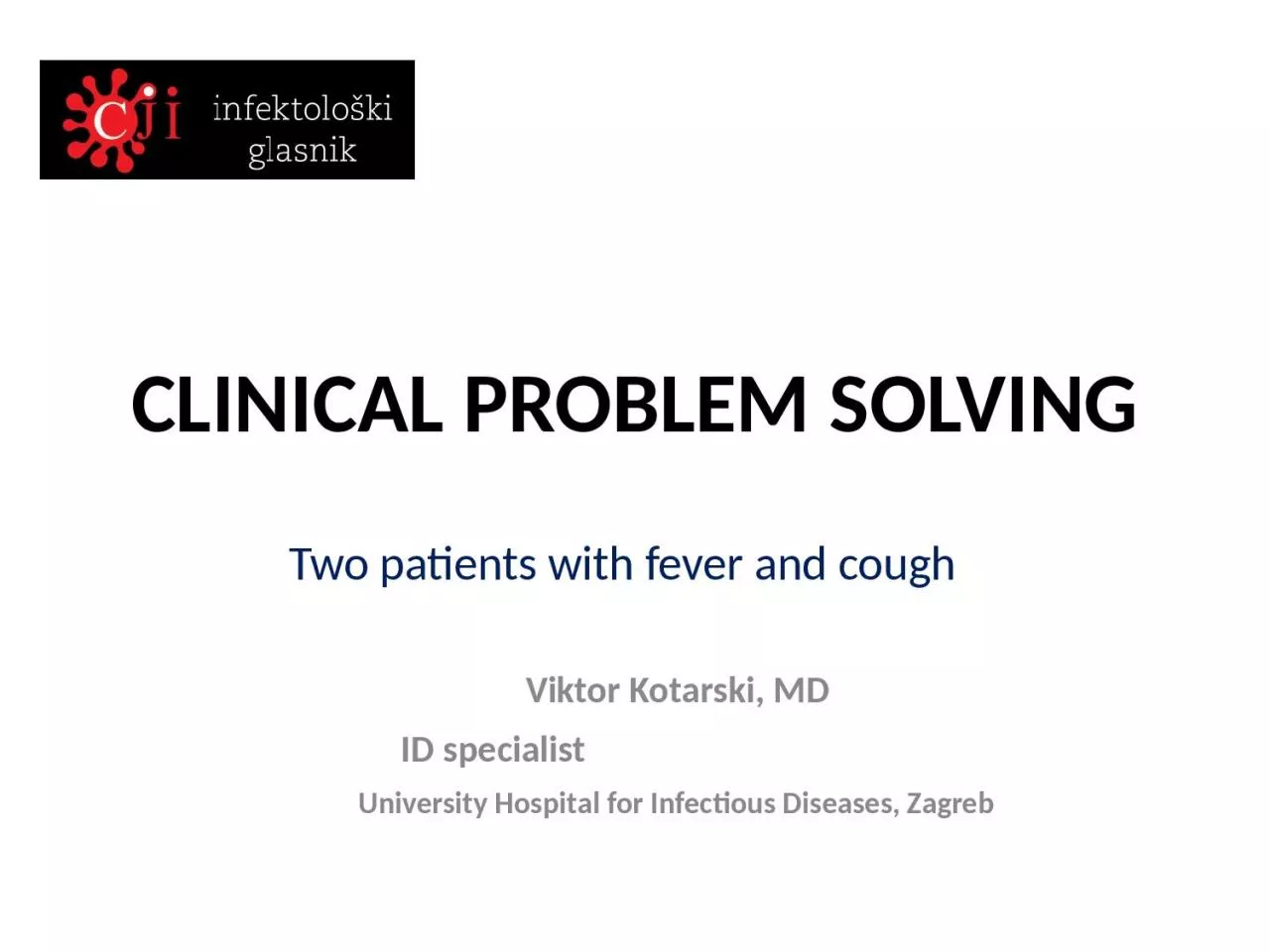

Two patients with fever and cough Viktor Kotarski MD ID specialist University Hospital for Infectious Diseases Zagreb Case 1 54 yearold male patient ID: 935170
Download Presentation The PPT/PDF document "CLINICAL PROBLEM SOLVING" is the property of its rightful owner. Permission is granted to download and print the materials on this web site for personal, non-commercial use only, and to display it on your personal computer provided you do not modify the materials and that you retain all copyright notices contained in the materials. By downloading content from our website, you accept the terms of this agreement.
Slide1
CLINICAL PROBLEM SOLVING
Two patients with fever and cough Viktor Kotarski, MD ID specialist University Hospital for Infectious Diseases, Zagreb
Slide2Case 154-year-old male patienthistory of diabetes type II and hypertensionpresents with a 3-day history of fever (up to
38.9 °C), cough, fatique and shortness of breaththe patient had had a cold for 3-4 prior to the onset of fever (nasal congestion, runny nose, sore throat)The next step:
Detailed history and clinical exam, basic lab
Detailed history and clinical exam, basic lab
, chest X-ray
Detailed history and clinical exam, basic lab
,
chest CT scan
Slide3The next step:
Detailed history and clinical exam, basic lab Detailed history and clinical exam, basic lab, chest X-ray
Detailed history and clinical exam, basic lab
,
chest CT scan
Slide4Case 1Detailed history and clinical exam:Temp. 39.2 °CBP 130/80 mmHg
Pulse 92/minRF 22/minSpO2 94%Awake, alert, orientedRales on auscultation on the right lung in the parascapular areaChest X-ray:Basic lab:
L 16.5 x 10
9
/cmm
CRP 208 g/L
Slide5Case 1The next step:treat in an outpatient settingadmit to the hospitaladmit to the ICU
Slide6Slide7Case 1The next step:treat in an outpatient settingadmit to the hospitaladmit to the ICU
Slide8Case 1Treatment :beta-lactam antibiotic (penicillin, amoxicillin, cephalosporin)macrolide (azythromycin)respiratory fluoroquinolone (moxifloxacin)
beta-lactam plus macrolidebeta-lactam plus fluoroquinolone
Slide9Case 1Treatment :beta-lactam antibiotic (penicillin, amoxicillin, cephalosporin)macrolide (azythromycin)respiratory fluoroquinolone (moxifloxacin)
beta-lactam plus macrolidebeta-lactam plus fluoroquinolone
Slide10Case 1In reality…The patient received azithromycin 1 x 500mg p.o. for 3 daysAfter completion of treatment he didn’t feel better and went to the ER
Slide11Case 1Detailed history and clinical exam:Temp. 38.5 °C BP 100/75 mmHgPulse 100/min
RF 30/minSpO2 92%Awake, alert, orientedCrackles in the right lung in the parascapular areaBasic lab:L 15.8 x 109/cmm
CRP 255 g/L
Chest X-ray:
No significant change in comparison to the last exam
Slide12Case 1The next step:treat in an outpatient settingadmit to the hospitaladmit to the ICU
Slide13Case 1Treatment:beta-lactam antibiotic (penicillin, amoxicillin, cephalosporin)macrolide (azythromycin)respiratory fluoroquinolone (moxifloxacin)
beta-lactam plus macrolidebeta-lactam plus fluoroquinolone
Slide14Case 1 - outcomeThe patient became afebrile 2 days after ceftriaxone was added to the treatment regimenVital signs stable and within normal limitsDischarged after 3 days
Slide15Case 248-year-old male patientpreviously healthypresents with a 4-day history of fever (up to 39.5 °C)
with rigors, chills and malaiseon the 4th day he started to cough
Slide16Case 2Detailed history and clinical exam:Temp. 39.2 °CBP 130/80 mmHgPulse 92/min
RF 22/minSpO2 94%Awake, alert, orientedRales on auscultation on the right lung in the parascapular areaChest X-ray:Basic lab:L 16.5 x 10
9/cmm
CRP 208 g/L
Slide17Case 2The patient was sent home with a prescription for amoxicillin 1 x 1000 mg p.o. for 10 daysAfter 4 days of treatment he didn’t feel better and came to the ER
Slide18Case 2Detailed history and clinical exam:Temp. 38.5 °CBP 130/75 mmHgPulse 100/min
RF 28/minSpO2 92%Awake, alert, orientedRales on auscultation on the right lung in the parascapular areaBasic lab:L 15.8 x 109/cmm
CRP 350 g/L
Chest X-ray:
Slide19Case 2The next step:treat in an outpatient settingadmit to the hospitaladmit to the ICU
Slide20Case 2The next step:treat in an outpatient settingadmit to the hospitaladmit to the ICU
Slide21Case 2The most probable cause of treatment failure:pleural effusion (empyema) or abscessresistant strain of S. pneumoniaeother pathogens (viruses,
S.aureus, Legionnaires disease, tuberculosis…)ARDSmalignancyother causes
Slide22Case 2Additional workup:chest CT scanbronchoscopymicrobiological tests
serology
Slide23Case 2Microbiological tests:blood culturesputum culturebronchoscopy + culture
tuberculosis culture, PCR, microscopy, QuantiFERON testrespiratory pathogens PCRlegionella antigen in urine
Slide24Case 2Treatment:beta-lactam antibiotic (penicillin, amoxicillin, cephalosporin)macrolide (azythromycin)respiratory fluoroquinolone (moxifloxacin)
beta-lactam plus macrolidebeta-lactam plus fluoroquinolone
Slide25Case 2Treatment:beta-lactam antibiotic (penicillin, amoxicillin, cephalosporin)macrolide (azythromycin)respiratory fluoroquinolone (moxifloxacin)
beta-lactam plus macrolidebeta-lactam plus fluoroquinolone
Slide26Case 2 - outcomeLegionnaire’s disease was diagnosed by positive Legionella urinary antigen testTreatment with moxifloxacin 1 x 400mg i.v. was initiatedInitially the patient required aditional oxygen (6L/min by face mask)He became afebrile after 3 days of therapy with moxifloxacin, vital signs stable and within normal limitsDischarged after 4 days to continue treatment with oral moxifloxacin for a total of 10 days
Slide27Treatment of CAP simplifiedVital signs!! Respiratory rate!!Outpatient setting: start with amoxicillin 3 x 500-1000 mg p.o. (watch for allergies!)Patients who require hospitalization: treat with combination therapy (beta-lactam plus macrolide) or respiratory fluoroquinolone (in case of allergies)Re-evaluate the patient after 3-4 days
If they are not getting better:maybe it’s not S. pneumoniae (consider Legionella, Mycoplasma, S.aureus, viruses, tuberculosis…) look for complications (pleural effusion, sepsis, ARDS)